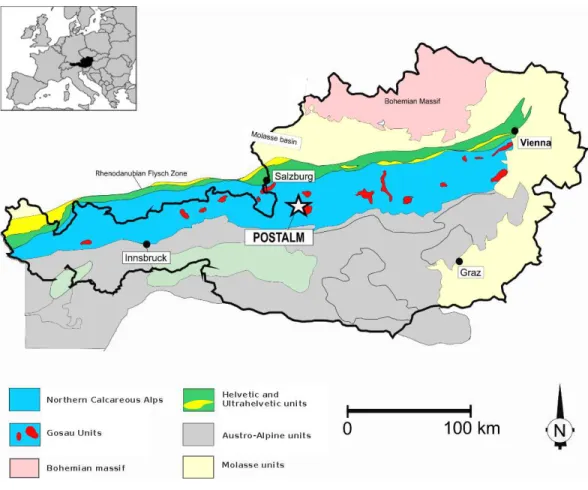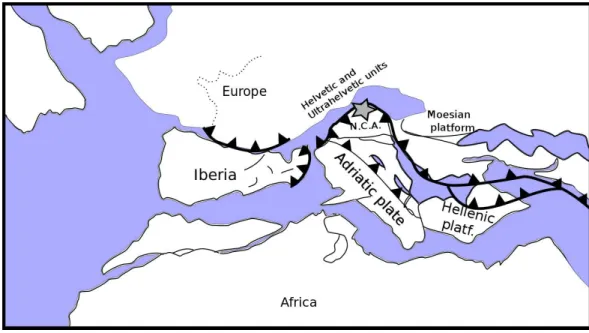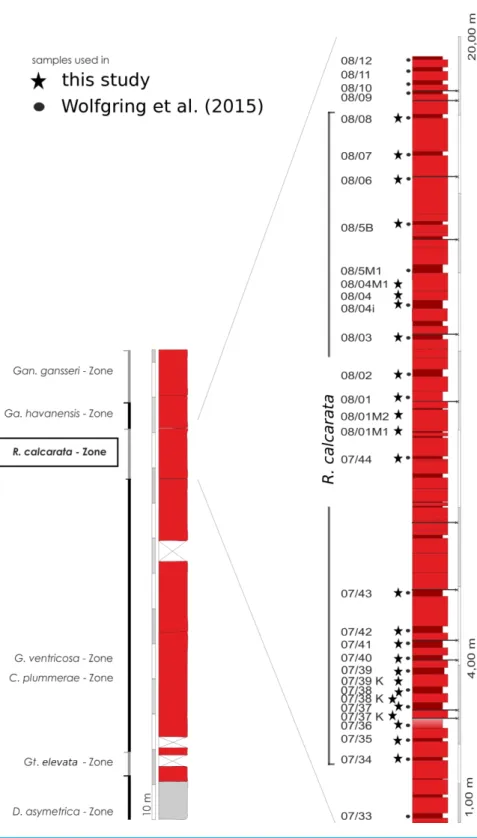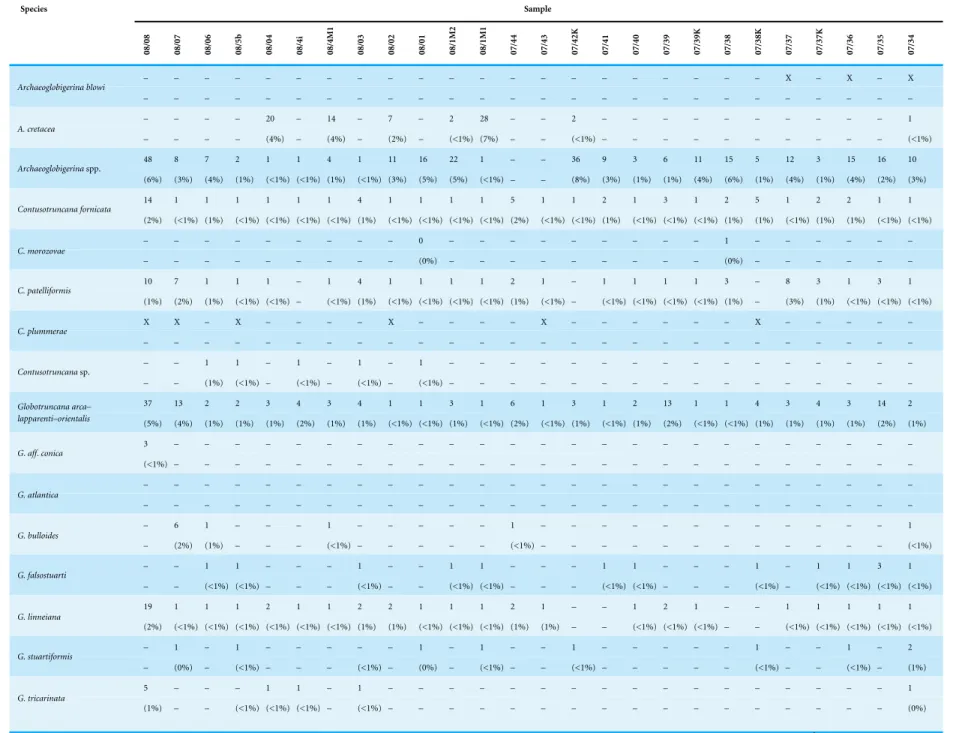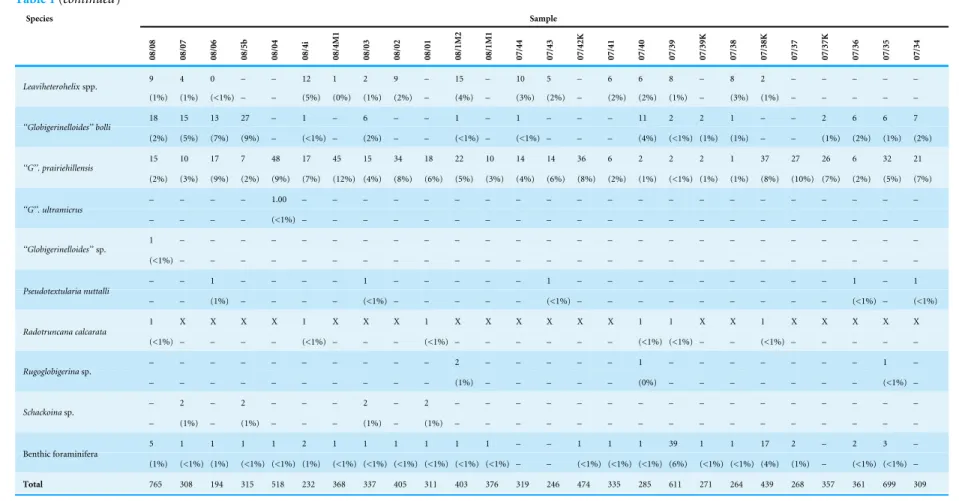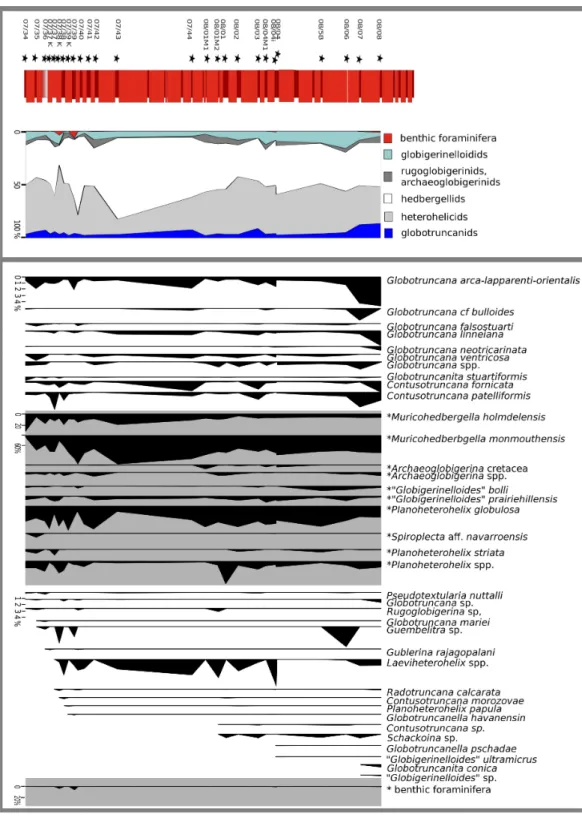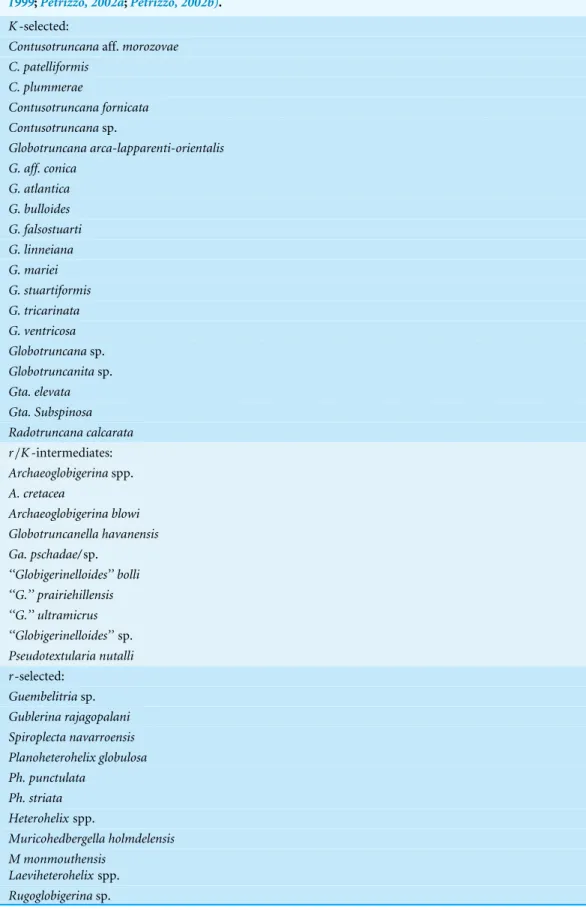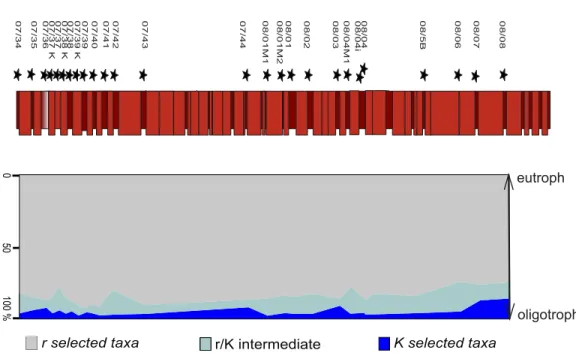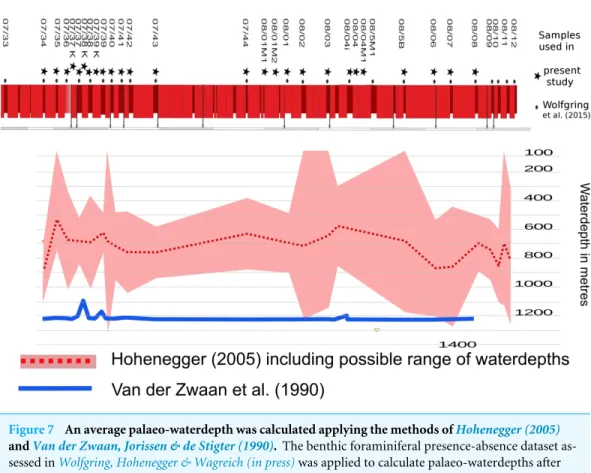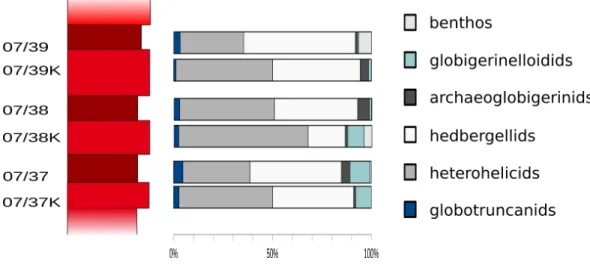Submitted5 October 2015 Accepted 13 February 2016 Published8 March 2016 Corresponding author Erik Wolfgring,
erik.wolfgring@univie.ac.at
Academic editor Laura Robinson
Additional Information and Declarations can be found on page 26
DOI10.7717/peerj.1757 Copyright
2016 Wolfgring and Wagreich
Distributed under
Creative Commons CC-BY 4.0 OPEN ACCESS
A quantitative look on northwestern
Tethyan foraminiferal assemblages,
Campanian Nierental Formation, Austria
Erik Wolfgring1,2and Michael Wagreich1
1Department of Geodynamics and Sedimentology, University of Vienna, Vienna, Austria 2Department of Palaeontology, University of Vienna, Vienna, Austria
ABSTRACT
Deposits spanning theRadotruncana calcarataTaxon Range Zone at the Postalm sec-tion, Northern Calcareous Alps (Austria) are examined quantitatively for foraminiferal assemblages, especially the planktonic group. This study focuses on establishing a high resolution record spanning an 800 ka long stratigraphic interval from the active continental margin of the Penninic Ocean. The Postalm section displays reddish limestone- marl alternations representing precession cycles. For this study, 26 samples were taken bed by bed to allow a ‘‘per-precession-cycle’’ resolution (i.e., a minimum sample distance of ∼20 ka). Samples from limestones as well as from marls were examined for foraminiferal assemblages. Data suggest a typical, open marine Campanian foraminiferal community. The >63µm fraction is dominated by
opportunist taxa, i.e., members ofMuricohedbergellaand biserial planktic foraminifera.
Archaeoglobigerinaand ‘‘Globigerinelloides’’ appear frequently and benthic foraminifera
are very sparsely found. The share of globotruncanids, representing more complex morphotypes amongst planktonic foraminifera, is recorded with 5–10%. The state of preservation of foraminifera from the Postalm section is moderate to poor. Differences between samples from marls and samples from limestone are evident, but do not reveal evidence that there was an influence on the postdepositional microfossil communities. However, data from microfossils showing moderate to bad preservation can still offer valuable insight into the palaeoenvironment and biostratigraphy. Information gathered on the composition of the planktonic foraminiferal assemblage confirms a low-to-mid-latitude setting for the Postalm section. As well resolved records of Late Cretaceous foraminifera assemblages are rare, the examination of the Radotruncana calcarata
Taxon Range Zone provides some insights into variations and short term changes during the very short period of 800 ka.
SubjectsEcology, Marine Biology, Paleontology
Keywords Cretaceous, Foraminifera, Palaeoecology, Biostratigraphy, Quantitative biostratigraphy
INTRODUCTION
The Late Cretaceous is a period recording major changes in the Earth’s climate system. Trends in climate evolution reflect the transition from a mid-Cretaceous hothouse to a more moderate greenhouse during the later part of the Late Cretaceous (e.g.,Barrera
& Savin, 1999;Huber, Norris & MacLeod, 2002;Friedrich et al., 2009;Friedrich, Norris &
Erbacher, 2012;Hay & Floegel, 2012;Jung et al., 2013;Price et al., 2013;Linnert et al., 2014;
Sames et al., 2015). Fundamental palaeoenvironmental processes influenced by climate and palaeoceanographic changes (e.g., the late Campanian—Maastrichtian cooling or sealevel changes of different magnitudes that affect chemical parameters like oxygen availability) can also be recognised as drivers behind modifications in the composition of foraminiferal assemblages, and especially planktonic foraminiferal communities, as discussed in this paper (Premoli Silva & Sliter, 1999;Abramovich et al., 2003;Friedrich,
Herrle & Hemleben, 2005;Falzoni et al., 2013).
The mid-to-late Campanian—from the base of theContusotruncana plummeraeZone at 79.2 Ma to the Campanian Maastrichtian boundary at 72.1 Ma (for the chronos-tratighraphic framework seeHuber, MacLeod & Tur, 2008;Anthonissen & Ogg, 2012)— is generally considered a time interval with a highly diversified planktonic foraminifera fauna (Premoli Silva & Sliter, 1999;Abramovich et al., 2003). Prolonged evolution and development of foraminiferal communities is known from the middle Campanian to Maastrichtian, coinciding with the onset of the general end-Cretaceous cooling trend
(Hart, 1999;Premoli Silva & Sliter, 1999;Georgescu, 2005). The radiation of
Archaeoglo-bigerinidae and RugogloArchaeoglo-bigerinidae, the diversification of biserial planktonic taxa, the appearance of complex morphotypes in globotruncanids—all of these are developments during the mid to late Campanian to Maastrichtian (Hart, 1999;Premoli Silva & Sliter,
1999;Georgescu, 2005).
Few high-resolution studies on general evolutionary trends, visible in the quantitative data from Campanian foraminifera communities exist. In general, most of quantitative studies on Late Cretaceous foraminiferal assemblages focus on developments around stage boundaries and/or events (e.g.,Huber et al., 1999;Arz & Molina, 2001;Odin &
Lamaurelle, 2001;Petrizzo, 2002a;Caron et al., 2006;Elamri & Zaghbib-Turki, 2014;
Elamri, Farouk & Zaghbib-Turki, 2014;Reolid et al., 2015). The vast majority deals with
the Cretaceous- Paleogene turnover (e.g.,Abramovich, Almogi-Labin & Benjamini, 1998;
Li & Keller, 1998;Arenillas et al., 2000;Abramovich & Keller, 2002;Karoui-Yaakoub,
Zaghbib-Turki & Keller, 2002;Premoli Silva, Emeis & Robertson, 2005;Gallala et al., 2009;
Beiranvand & Ghasemi-Nejad, 2013, see alsoPardo & Keller, 2008for a compilation of
selected quantitative databases on the Cretaceous-Paaeogene boundary).
An almost complete Santonian-lower Maastrichtian succession is recorded in pelagic to hemipelagic deposits at the Postalm section, Austria, at the NW margin of the Tethys (Fig. 1). The study ofWagreich, Hohenegger & Neuhuber (2012)addresses the bios-tratigraphy, as well as the astronomical calibration of theR. calcarataZone in the mid-Campanian at Postalm. With its rather short duration of only 800 ka (806.3 ka in the study ofWagreich, Hohenegger & Neuhuber, 2012;Robaszynski & Mzoughi, 2010, give a mean duration of 790 ka), and the distinct morphology of the nominative taxon,
theRadotruncana calcarataTaxon-range Zone is considered a well-established, easily
recognisable and reliable time interval in Late Cretaceous chronostratigraphy of the Tethyan Realm (e.g.,Robaszynski et al., 1984;Chungkham & Jafar, 1998;Premoli Silva,
Spezzaferi & D’Angelantonio, 1998;Puckett & Mancini, 1998;Huber, MacLeod & Tur, 2008;
Wendler et al., 2011).
Figure 1 Geological sketch-map of the Austrian Alps.The Postalm section is situated some kilometres south of the city of Salzburg. The inset explains the geographical context.
Wolfgring, Hohenegger & Wagreich (in press)reported biostratigraphic and qualitative
foraminiferal data based on presence–absence data from two sections on opposite margins of the Penninic Ocean, including data from the Postalm section. The latter displayed a remarkably static composition of foraminiferal assemblages in theRadotruncana
calcarataZone. The sudden appearance and disappearance of the zonal marker and the
disappearance ofGlobotruncanita elevatawere the only biostratigraphic events recorded in the planktonic foraminifera record from this section.
In this work we present a quantitative study on planktonic foraminiferal assemblages in
theR. calcarataZone at Postalm section. With 26 samples in the 803.6 ka long interval,
this high-resolution study gives information on the composition of typical Tethyan pelagic assemblages. This work deals with subtle changes in north-western planktonic foraminiferal communities on the brink of the Late Cretaceous cooling and major faunal turnover-events (Premoli Silva & Sliter, 1999). With adding the quantitative aspect of a comparatively short episode of the Tethyan Campanian to the presence–absence data assessed inWolfgring, Hohenegger & Wagreich (in press)we aim at a better understanding of small scale changes in the foraminiferal record (e.g., the extinction ofR. calcarataand
Gta. elevata).
Geological setting
Units forming the Northern Calcareous Alps (NCA) were deposited along the northern margin of the Austroalpine domain on the Adriatic microplate (Wagreich, 1993), at the southern margin of the Penninic Ocean (‘‘Alpine Tethys’’ ofStampfli & Borel, 2002;
Handy et al., 2010), which was a north-western part of the Tethys oceanic system (see also
Neuhuber et al., 2007).
Within the system of the NCA, the Upper Cretaceous to Paleogene Gosau Group is characterised by the terrestrial to shallow marine Lower Gosau Subgroup and the deep-water deposits of the Upper Gosau Subgroup. The Lower Gosau Subgroup of Turonian to Santonian age filled pull-apart basins alongside an oblique subduction—strike-slip zone
(Wagreich & Decker, 2001). After a short phase of tectonically induced uplift of the NCA,
rapid subsidence processes resulted in the sedimentation of the pelagic, hemipelagic and turbiditic Upper Gosau Subgroup, comprising strata of Santonian/Campanian to Eocene age (Wagreich, 1993;Krenmayr, 1999;Wagreich et al., 2011;Hofer et al., 2011).
The Postalm section (coordinates WGS 84 013◦23′11′′E;47◦36′44′′N) belongs to the
Nierental Formation of the Upper Gosau Subgroup (Fig. 1) (Krenmayr, 1996;Wagreich &
Krenmayr, 2005;Wagreich, Hohenegger & Neuhuber, 2012). The Nierental Formation was
originally deposited at palaeolatitudes of approximately 35—30◦N, alongside the southern
margin of the Penninic Ocean (Fig. 2). The Santonian to Maastrichtian succession at Postalm is characterised by distinct marly limestone—marl cycles and records an upper to middle bathyal depositional environment (Wagreich, Hohenegger & Neuhuber, 2012) (Fig. 3). Marly limestones can be classified as foraminiferal packstone. The Postalm section is interpreted as a pelagic to hemipelagic depositional environment well above the CCD. The section was part of a northward deepening slope within the NCA with bathyal water-depths (Wagreich & Krenmayr, 2005;Wolfgring, Hohenegger & Wagreich, in press).
The deposits recorded at the Postalm section are interpreted as Cretaceous Oceanic Red Beds (CORB), indicating overall well oxygenated bottom waters (Hu et al., 2005;
Wa-greich & Krenmayr, 2005). The sediment accumulation rate is estimated to be 20 mm/ka
(Wagreich, Hohenegger & Neuhuber, 2012).
For more detailed information on the geological setting at Postalm section, the reader is referred toWagreich, Hohenegger & Neuhuber (2012).
MATERIAL AND METHODS
Sampling and samples preparation
TheRadotruncana calcarataTaxon Range Zone (TRZ) was sampled bed-by-bed, following
biostratigraphic investigation ofWagreich, Hohenegger & Neuhuber (2012)andNeuhuber
et al. (2015). No standard sampling distance was applied.Figure 4gives an overview
on the stratigraphic framework and the location of sample-spots used inWolfgring,
Hohenegger & Wagreich (in press)and in the present study. Twentysix samples from
marls and marly limestones were processed to obtain quantitative data. Marl and marly-limestone samples were soaked in the tenside Rewoquadc for 24 h and then thoroughly
rinsed with water. Samples were thereafter soaked in hydrogen peroxide (35%) for 1 h
Figure 2 Palaeogeographic reconstruction of the Penninic realm (redrawn, simplified and modified fromSchettino & Turco, 2011).The Postalm section (grey star) is located in the Northern Calcareous Alps (N.C.A.) on the southern active margin of the Penninic Ocean.
Figure 3 Detail of cyclic marl-marly limestone alternations at Postalm depicting the older part of the
R. calcaratainterval.Black dots show sample locations.
and wet sieved. Firm foraminifera packstone required intense treatment; cooking the samples in hydrogen peroxide for ten minutes and the repeated use of tensides was mandatory. Disaggregated samples were washed over 63µm and 125µm mesh sieves. The
residues were dried overnight at 60◦.
Quantitative data were assessed using the >63µm size fractions. ‘‘Larger’’ foraminifera
(>125µm) were assigned genus and species, while the 63–125µm fraction is mostly
Figure 4 Overview of the geological setting at Postalm section and theR. calcaratainterval in detail.
Sample points from this the present study are flagged with stars. Samples used for the assessment of presence-absence data inWolfgring, Hohenegger & Wagreich (in press)are flagged with black dots.
discussed on genus level, as, in some cases, the state of preservation did not permit the identification of taxonomically relevant features. According to micropalaeontological standard procedures, per sample at least some 300 specimen of both planktic and benthic foraminifera were counted. Data were obtained from marls, as well as marly limestones.
The tool PanPlot 2 (Sieger & Grobe, 2013) was used to visualise foraminifera abun-dances in Postalm section.
Samples and microslides are stored in the Earth Science collections at the Department of Geodynamics and Sedimentology, University of Vienna.
Palaeodepth estimates
Depositional palaeo-waterdepth was calculated applying the method published inVan der
Zwaan, Jorissen & De Stigter (1990). Here, the palaeodepth in meters is estimated as:
D(m)=e3.58718+(0.03534×P) (1)
whereD(m) is the estimated palaeodepth in metres,eis the mathematical constant Euler’s number andPthe ratio of planktonic/benthic foraminifera. The calculation ofPexcludes benthic foraminiferal taxa from the analysis that are not directly dependent on the flux of organic matter to the seafloor (Van der Zwaan, Jorissen & De Stigter, 1990;Kopecká, 2012). This is the case with a mono-specific mass occurrence ofNothiasp. at the Postalm section. As episodic blooms in this taxon could be a possible reason for the high share in some samples this taxon has been excluded from this analysis.
In addition to the method ofVan der Zwaan, Jorissen & De Stigter (1990)that relies on the quantitative data assessed in this study, presence–absence data of benthic foraminifera recorded at the Postalm section (Wolfgring, Hohenegger & Wagreich, in press) was used to calculate palaeo water depth applying the method ofHohenegger (2005). The basic formula for estimating the depth gradient is given as:
g=
m X
i=1
lidi−1
m
X
i=1
di−1 (2)
whereiiis the mean depth anddithe distribution range along the taxon’s depth range and
g the estimated palaeodepth.
Depth ranges of benthic foraminifera (seeAppendix S1) are inferred from the palaeos-lope model ofNyong & Olssen (1984)with depth ranges for Campanian-Maastrichtian benthic foraminifera along the Atlantic coast, as well as the bathymetric ranges of benthic foraminifera ofSliter & Baker (1972),Speijer & Van der Zwaan (1996),Kaminski &
Gradstein (2005),Valchev (2006)as well asHolbourn, Henderson & MacLeod (2013).
Taxonomic remarks/methods and the preservation of microfossils
With few exceptions, the state of preservation in the investigated samples can be con-sidered moderate to poor. Most spiral and trochospiral planktic and benthic forms appear with fully intact tests. No signs of dissolution were recorded. Some planktonic foraminifera show evidence of recrystallisation and carbonate infilling. Elongated forms frequently appear fragmented. However, the state of preservation did not allow the
definite taxonomic assignment of some individuals to species level. Thus, morphogroups for certain taxa were established.
Some double keeled, biconvex globotruncanid taxa (Globotruncana arca, G. lapparenti,
G. orientalis) have subsequently been merged toGlobotruncana arca-lapparenti-orientalis,
as morphological transitions were observed. Some biserial planktonic specimens displayed a very bad state of preservation, rendering the identification of some individuals on species level impossible. These specimens were aggregated into the groupPlanoheterohelix spp. Biserial planktonic taxa with reniform chambers were pooled underLaeviheterohelixspp.
Planktonic foraminiferal taxonomy predominantly follows Nederbragt (1991),
Robaszynski & Caron (1995)andPremoli Silva & Verga (2004).Georgescu & Huber (2009)
andPetrizzo, Falzoni & Premoli Silva (2011), Genera with their taxonomy under revision
appear in quotes. Some significant taxa of the section are pictured inWolfgring, Hohenegger
& Wagreich (in press).
To define the trophic characteristics of the investigated area, we determined the distribution of r- and K-strategists. The r-strategists are generally considered to be opportunists and adapted to eutrophic or unstable conditions; K-strategists represent more complex morphotypes that favour stable, rather oligotrophic environments (Premoli
Silva & Sliter, 1999;Petrizzo, 2002a;Petrizzo, 2002b;Gebhardt et al., 2010).
Benthic foraminiferal taxa were not assigned genus and species. Benthic foraminifera are extremely sparse in standard quantitative data. The number of benthic specimen per sample was recorded but we refrained from any taxonomic assignment. Presence–absence data on the benthic foraminiferal record (fromWolfgring, Hohenegger & Wagreich, in press) is available in theAppendix S1.
RESULTS
Quantitative data
The quantitative investigation of theR. calcarata TRZ displays the composition of a typical mid Campanian low to mid-latitude Tethyan foraminiferal community and records at least 42 different planktonic foraminiferal species in 15 genera (Fig. 5). Benthic foraminifera are very sparse in quantitative data. Table 1displays the number of specimens as well as the relative abundances of foraminiferal species. The foraminiferal assemblage at Postalm is dominated by members of heterohelicids and the genus Muricohedbergella. These two groups account for up to 80% of the total assemblage. Small heterohelicid taxa are dominated byPlanoheterohelix globulosa. We can confirm the presence ofPseudotextularia
nuttalli, Gublerina rajagopalani, Ph. striata, Spiroplecta navarroensis andGuembelitriasp.
However, the groupsPlanoheterohelix spp. andLaeviheterohelixspp. comprise a relatively high proportion of the assemblage. Multiserial or flaring heterohelicids were not detected.
The genus Muricohedbergella is represented by the species M. holmdelensis and
M. monmouthensisin varying numbers. The share of this group slightly increases towards
the top of theR. calcarataTRZ.
Globotruncanids are less abundant and represent between 1 and 12 percent. This group is represented by the generaGlobotruncana, Globotruncanella, Globotruncanita,
Table 1 Displays the proportional frequencies of foraminiferal taxa per sample at the Postalm section.
Species Sample
08/08 08/07 08/06 08/5b 08/04 08/4i 08/4M1 08/03 08/02 08/01 08/1M2 08/1M1 07/44 07/43 07/42K 07/41 07/40 07/39 07/39K 07/38 07/38K 07/37 07/37K 07/36 07/35 07/34
– – – – – – – – – – – – – – – – – – – – – X – X – X
Archaeoglobigerina blowi
– – – – – – – – – – – – – – – – – – – – – – – – – –
– – – – 20 – 14 – 7 – 2 28 – – 2 – – – – – – – – – – 1
A. cretacea
– – – – (4%) – (4%) – (2%) – (<1%) (7%) – – (<1%) – – – – – – – – – – (<1%)
48 8 7 2 1 1 4 1 11 16 22 1 – – 36 9 3 6 11 15 5 12 3 15 16 10
Archaeoglobigerinaspp.
(6%) (3%) (4%) (1%) (<1%) (<1%) (1%) (<1%) (3%) (5%) (5%) (<1%) – – (8%) (3%) (1%) (1%) (4%) (6%) (1%) (4%) (1%) (4%) (2%) (3%)
14 1 1 1 1 1 1 4 1 1 1 1 5 1 1 2 1 3 1 2 5 1 2 2 1 1
Contusotruncana fornicata
(2%) (<1%) (1%) (<1%) (<1%) (<1%) (<1%) (1%) (<1%) (<1%) (<1%) (<1%) (2%) (<1%) (<1%) (1%) (<1%) (<1%) (<1%) (1%) (1%) (<1%) (1%) (1%) (<1%) (<1%)
– – – – – – – – – 0 – – – – – – – – – 1 – – – – – –
C. morozovae
– – – – – – – – – (0%) – – – – – – – – – (0%) – – – – – –
10 7 1 1 1 – 1 4 1 1 1 1 2 1 – 1 1 1 1 3 – 8 3 1 3 1
C. patelliformis
(1%) (2%) (1%) (<1%) (<1%) – (<1%) (1%) (<1%) (<1%) (<1%) (<1%) (1%) (<1%) – (<1%) (<1%) (<1%) (<1%) (1%) – (3%) (1%) (<1%) (<1%) (<1%)
X X – X – – – – X – – – – X – – – – – – X – – – – –
C. plummerae
– – – – – – – – – – – – – – – – – – – – – – – – – –
– – 1 1 – 1 – 1 – 1 – – – – – – – – – – – – – – – –
Contusotruncanasp.
– – (1%) (<1%) – (<1%) – (<1%) – (<1%) – – – – – – – – – – – – – – – –
37 13 2 2 3 4 3 4 1 1 3 1 6 1 3 1 2 13 1 1 4 3 4 3 14 2
Globotruncana arca–
lapparenti–orientalis (5%) (4%) (1%) (1%) (1%) (2%) (1%) (1%) (<1%) (<1%) (1%) (<1%) (2%) (<1%) (1%) (<1%) (1%) (2%) (<1%) (<1%) (1%) (1%) (1%) (1%) (2%) (1%)
3 – – – – – – – – – – – – – – – – – – – – – – – – –
G.aff.conica
(<1%) – – – – – – – – – – – – – – – – – – – – – – – – –
– – – – – – – – – – – – – – – – – – – – – – – – – –
G. atlantica
– – – – – – – – – – – – – – – – – – – – – – – – – –
– 6 1 – – – 1 – – – – – 1 – – – – – – – – – – – – 1
G. bulloides
– (2%) (1%) – – – (<1%) – – – – – (<1%) – – – – – – – – – – – – (<1%)
– – 1 1 – – – 1 – – 1 1 – – – 1 1 – – – 1 – 1 1 3 1
G. falsostuarti
– – (<1%) (<1%) – – – (<1%) – – (<1%) (<1%) – – – (<1%) (<1%) – – – (<1%) – (<1%) (<1%) (<1%) (<1%)
19 1 1 1 2 1 1 2 2 1 1 1 2 1 – – 1 2 1 – – 1 1 1 1 1
G. linneiana
(2%) (<1%) (<1%) (<1%) (<1%) (<1%) (<1%) (1%) (1%) (<1%) (<1%) (<1%) (1%) (1%) – – (<1%) (<1%) (<1%) – – (<1%) (<1%) (<1%) (<1%) (<1%)
– 1 – 1 – – – – – 1 – 1 – – 1 – – – – – 1 – – 1 – 2
G. stuartiformis
– (0%) – (<1%) – – – (<1%) – (0%) – (<1%) – – (<1%) – – – – – (<1%) – – (<1%) – (1%)
5 – – – 1 1 – 1 – – – – – – – – – – – – – – – – – 1
G. tricarinata
(1%) – – (<1%) (<1%) (<1%) – (<1%) – – – – – – – – – – – – – – – – – (0%)
(continued on next page)
Table 1(continued)
Species Sample
08/08 08/07 08/06 08/5b 08/04 08/4i 08/4M1 08/03 08/02 08/01 08/1M2 08/1M1 07/44 07/43 07/42K 07/41 07/40 07/39 07/39K 07/38 07/38K 07/37 07/37K 07/36 07/35 07/34
– – 1 1 1 1 – 1 2 1 1 1 2 1 2 1 – – 1 – – – – 2 7 1
G. ventricosa
– – (1%) (<1%) (<1%) (<1%) – (<1%) (1%) (<1%) (<1%) (<1%) (1%) (<1%) (<1%) (<1%) – – (<1%) – – – – (<1%) (1%) (<1%)
– – – – – – – – – – – – – – – – – – – – – – – 1 – –
G. mariei
– – – – – – – – – – – – – – – – – – – – – – – (0%) – –
– 4 1 1 2 – 2 – 3 1 3 1 – – 2 – – – – – – – – 2 4 2
Globotruncanasp.
– (1%) (<1%) (<1%) (<1%) – (1%) – (1%) (<1%) (1%) (<1%) – – (1%) – – – – – – – – (0%) (1%) (1%)
– – – – – 1 – – – – – – – – – – – 1 – – – – – – – –
Globotruncanella havanensis
– – – – – (<1%) – – – – – – – – – – – (<1%) – – – – – – – –
– – – – 1 – – – – – – – – – – – – – – – – – – – – –
Ga. pschadae/sp
– – – – (<1%) – – – – – – – – – – – – – – – – – – – – –
1 – – – – – – – – – – – – – – – 1 1 – 1 – – – – 1 –
Globotruncanitasp.
(<1%) – – – – – – – – – – – – – – – (<1%) (<1%) – (<1%) – – – – (<1%) –
– – – – – – – – – – – – – – – – X – X – – – – X – X
Gta. elevata
– – – – – – – – – – – – – – – – – – – – – – – – – –
– – – – – – – – – – – – – – – X – – – – – – – – – –
Gta. subspinosa
– – – – – – – – – – – – – – – – – – – – – – – – – –
– – 6 – – – – – – – – – – – – – – 10 1 – 12 – – 2 – –
Guembelitrasp.
– – (3%) – – – – – – – – – – – – – – (2%) (<1%) – (3%) – – (<1%) – –
54 22 13 20 38 17 27 28 16 28 44 31 39 51 45 39 47 64 26 56 37 37 32 69 42 104
Muricohedbergella
holmde-lensis (7%) (7%) (6%) (6%) (7%) (7%) (7%) (8%) (4%) (9%) (11%) (8%) (12%) (21%) (9%) (12%) (16%) (10%) (10%) (21%) (8%) (14%) (9%) (19%) (6%) (34%)
267 101 57 99 200 79 102 106 104 105 130 142 148 137 125 117 161 280 91 55 45 86 114 69 206 10
M. monmouthensis
(35%) (33%) (29%) (31%) (39%) (34%) (28%) (32%) (26%) (34%) (32%) (38%) (47%) (56%) (27%) (35%) (57%) (46%) (34%) (21%) (10%) (32%) (32%) (19%) (30%) (3%)
168 64 54 125 144 78 133 99 165 – 127 152 86 25 214 117 27 142 128 67 174 39 160 106 165 92
Planoheterohelix globulosa
(22%) (21%) (28%) (40%) (28%) (34%) (36%) (30%) (41%) – (32%) (41%) (27%) (10%) (45%) (35%) (9%) (23%) (47%) (26%) (40%) (15%) (45%) (29%) (24%) (30%)
– – – – – – – – 1 – – – – – – – – – 1 – – – – – – –
Ph. pupa
– – – – – – – – (<1%) – – – – – – – – – (<1%) – – – – – (<1%) –
– – – – – – – – – – – – – – – – 1 – – – – – 1 – – –
Gublerina rajagopalani
– – – – – – – – – – – – – – – – (<1%) – – – – – (<1%) – (<1%) –
6 3 1 17 – 1 – 5 17 1 – 1 – 1 – – 1 2 1 1 2 31 6 – 54 11
Ph. striata
(1%) (1%) (1%) (5%) – (<1%) – (1%) (4%) (<1%) – (<1%) – (<1%) – – (<1%) (<1%) (<1%) (1%) (1%) (12%) (2%) – (8%) (4%)
84 43 13 5 53 12 30 51 28 130 26 1 2 5 3 33 17 33 1 49 95 21 1 72 85 37
Planoheterohelixspp.
(11%) (14%) (6%) (2%) (10%) (5%) (8%) (15%) (7%) (42%) (6%) (<1%) (1%) (2%) (1%) (10%) (6%) (5%) (<1%) (18%) (22%) (8%) (<1%) (20%) (12%) (12%)
– – – – – 1 – – – – – – – – – – 1 – – – – – – 1 54 –
‘‘Spiroplecta’’ navarroensis
– – – – – (<1%) – – – – – – – – – – (<1%) – – – – – – (<1%) (8%) –
(continued on next page)
Table 1(continued)
Species Sample
08/08 08/07 08/06 08/5b 08/04 08/4i 08/4M1 08/03 08/02 08/01 08/1M2 08/1M1 07/44 07/43 07/42K 07/41 07/40 07/39 07/39K 07/38 07/38K 07/37 07/37K 07/36 07/35 07/34
9 4 0 – – 12 1 2 9 – 15 – 10 5 – 6 6 8 – 8 2 – – – – –
Leaviheterohelixspp.
(1%) (1%) (<1%) – – (5%) (0%) (1%) (2%) – (4%) – (3%) (2%) – (2%) (2%) (1%) – (3%) (1%) – – – – –
18 15 13 27 – 1 – 6 – – 1 – 1 – – – 11 2 2 1 – – 2 6 6 7
‘‘Globigerinelloides’’ bolli
(2%) (5%) (7%) (9%) – (<1%) – (2%) – – (<1%) – (<1%) – – – (4%) (<1%) (1%) (1%) – – (1%) (2%) (1%) (2%)
15 10 17 7 48 17 45 15 34 18 22 10 14 14 36 6 2 2 2 1 37 27 26 6 32 21
‘‘G’’. prairiehillensis
(2%) (3%) (9%) (2%) (9%) (7%) (12%) (4%) (8%) (6%) (5%) (3%) (4%) (6%) (8%) (2%) (1%) (<1%) (1%) (1%) (8%) (10%) (7%) (2%) (5%) (7%)
– – – – 1.00 – – – – – – – – – – – – – – – – – – – – –
‘‘G’’. ultramicrus
– – – – (<1%) – – – – – – – – – – – – – – – – – – – – –
1 – – – – – – – – – – – – – – – – – – – – – – – – –
‘‘Globigerinelloides’’sp.
(<1%) – – – – – – – – – – – – – – – – – – – – – – – – –
– – 1 – – – – 1 – – – – – 1 – – – – – – – – – 1 – 1
Pseudotextularia nuttalli
– – (1%) – – – – (<1%) – – – – – (<1%) – – – – – – – – – (<1%) – (<1%)
1 X X X X 1 X X X 1 X X X X X X 1 1 X X 1 X X X X X
Radotruncana calcarata
(<1%) – – – – (<1%) – – – (<1%) – – – – – – (<1%) (<1%) – – (<1%) – – – – –
– – – – – – – – – – 2 – – – – – 1 – – – – – – – 1 –
Rugoglobigerinasp.
– – – – – – – – – – (1%) – – – – – (0%) – – – – – – – (<1%) –
– 2 – 2 – – – 2 – 2 – – – – – – – – – – – – – – – –
Schackoinasp.
– (1%) – (1%) – – – (1%) – (1%) – – – – – – – – – – – – – – – –
5 1 1 1 1 2 1 1 1 1 1 1 – – 1 1 1 39 1 1 17 2 – 2 3 –
Benthic foraminifera
(1%) (<1%) (1%) (<1%) (<1%) (1%) (<1%) (<1%) (<1%) (<1%) (<1%) (<1%) – – (<1%) (<1%) (<1%) (6%) (<1%) (<1%) (4%) (1%) – (<1%) (<1%) –
Total 765 308 194 315 518 232 368 337 405 311 403 376 319 246 474 335 285 611 271 264 439 268 357 361 699 309
W
olfgring
and
W
agr
eich
(2016),
P
eerJ
,
DOI
10.7717/peerj.1757
Figure 5 Relative abundance of foraminiferal species in theR. calcaratainterval at Postalm section (>63µm). Species marked with an asterisk are necessarily displayed at a different scale. Species are in or-der of their stratigraphical appearance.
Table 2 Life strategies of planktonic foraminifera at Postalm section (afterPremoli Silva & Sliter, 1999;Petrizzo, 2002a;Petrizzo, 2002b).
K-selected:
Contusotruncanaaff.morozovae C. patelliformis
C. plummerae
Contusotruncana fornicata Contusotruncanasp.
Globotruncana arca-lapparenti-orientalis G. aff. conica
G. atlantica G. bulloides G. falsostuarti G. linneiana G. mariei G. stuartiformis G. tricarinata G. ventricosa Globotruncanasp.
Globotruncanitasp.
Gta. elevata Gta. Subspinosa Radotruncana calcarata r/K-intermediates:
Archaeoglobigerinaspp.
A. cretacea
Archaeoglobigerina blowi Globotruncanella havanensis Ga. pschadae/sp.
‘‘Globigerinelloides’’ bolli ‘‘G.’’ prairiehillensis ‘‘G.’’ ultramicrus ‘‘Globigerinelloides’’sp.
Pseudotextularia nutalli r-selected:
Guembelitriasp.
Gublerina rajagopalani Spiroplecta navarroensis Planoheterohelix globulosa Ph. punctulata
Ph. striata Heterohelixspp.
Muricohedbergella holmdelensis M monmouthensis
Laeviheterohelixspp.
Rugoglobigerinasp.
ContusotruncanaandRadotruncana. The groupGlobotruncana arca-lapparenti-orientalis
comprises several double keeled, biconvex taxa, and was, as expected, most frequently detected within the globotruncanid lineage. Other globotruncanid taxa, such as G.
linneiana, G. ventricosa. G. mariae, G. falsostuarti, as well asC. patelliformisandC. fornicata
are present throughout the section. The zonal marker—Radotruncana calcarata—is a comparatively rare element at Postalm that accounts for only a maximum of 1% of the assemblage.
The genus ‘‘Globigerinelloides’’ is present in numbers up to 15%, including ‘‘G’’. bolli,
‘‘G’’. ultramicrusand ‘‘G’’. multispinus.Archaeoglobigerinais mainly represented by two
taxa,A. cretaceaandA. blowi. Rugoglobigerinids (presumablyR. rugosa?) are less abundant. The planktic/benthic foraminifera ratio is very high throughout the section. Benthic foraminifera never display a higher share than 6%. Quantitative data show a peak in benthic foraminifera abundance in the lower part of the section (samples 7/38K and 7/39). High abundance in 7/39 is inferred by high numbers of tubular agglutinating taxa (presumably
Nothiaspp.).
Life strategies of planktonic foraminifera
Upon examination of the >63 µm fraction, the foraminiferal assemblage displays
opportunisticr-strategists as the dominant element, as small biserial and trochospiral taxa account for an overwhelming majority of individuals. K-strategists, which are exclusively represented by globotruncanids at Postalm, are mostly recorded with less than ten percent. Taxa showing a life strategy that cannot be clearly assigned, such as ‘‘r/K-intermediate’’ selected taxa such as ‘‘Globigerinelloides’’, show a similar frequency pattern asK-selected species. Table 2shows the taxa recorded at the Postalm section and their life strategy.
Figure 6displays the distribution of taxa with respect to their life strategy and the inferred environmental characteristics.
DISCUSSION
Examining foraminiferal assemblages from a bathyal environment of an active continental margin preserved in a mountain belt has some drawbacks. This study has to deal with poor preservation of microfossils due to a strong diagenetic overprint and minor folding and faulting of the sections. Still, records with restricted taxonomical resolution (especially with smaller foraminifera, i.e.,∼63–125µm) can give some indication of the palaeoecology and
biostratigraphy; conspicuous biostratigraphic marker species are still clearly identifiable. If the loss of taxonomic information only permits the identification at the genus level, especially for small (<125 µm) morphotypes, comparison of the relative abundance of
foraminiferal taxa is still possible. Likewise, the distribution of r- andK-strategists is a measurement that can typically be determined at genus level (Hart, 1999;Premoli Silva &
Sliter, 1999;Petrizzo, 2002a;Petrizzo, 2002b;Gebhardt et al., 2010).
Implications for biostratigraphy and palaeoenvironment
TheRadotruncana calcarataZone was first introduced byHerm (1962)and defines the
in-terval between the first occurrence (FO) and the last occurrence (LO) of the nominate taxon.
Figure 6 Frequency of foraminifera in respect to their ecological characteristics.The vast majority of individuals in the >63µm fraction assign to opportunisticr-selected taxa (grey),r/Kintermediates (light blue) andK-selected taxa (dark blue) are represented by 10% each.
For a long time the top of theR. calcaratainterval was used to define the Campanian— Maastrichtian boundary in plankton biostratigraphic zonations for the Late Cretaceous (e.g., Salaj & Samuel, 1966; Caron, 1985; Sliter, 1989). Today, chronostratigraphic correlations position this interval in the mid Campanian (Robaszynski & Caron, 1995—
as Globotruncana calcarataTRZ,Premoli Silva & Sliter, 1999;Berggren & Pearson, 2005;
Huber, MacLeod & Tur, 2008;Robaszynski & Mzoughi, 2010;Ogg & Hinnov, 2012).
Other studies concerned with theRadotruncana calcarataTRZ also recordedG. angulata
(as G. cf. angulata in Hart, 1987), Pseudoguembelitria costulata (Li & Keller, 1998),
Rugoglobigerina hexacamerata, ‘‘Globigerinelloides’’ yaucoensis(Arz & Molina, 2001),
Globotruncana aegyptiaca(Arz & Molina, 2001;Chacón, Martín-Chivelet & Gräfe, 2004),
‘‘Globigerinelloides’’ messinae andPseudoguembelina costualta (Premoli Silva, Emeis &
Robertson, 2005) andGlobotruncana rosetta (Robaszynski & Mzoughi, 2010). These taxa
were not identified in theR. calcarataZone at the Postalm section.
In our section from the Northern Calcareous Alps we seem to document the extinction
of Globotruncanita elevata within theR. calcarata TRZ (see Wolfgring, Hohenegger &
Wagreich, in press). Generally, the LO of this taxon is considered to have occurred
shortly before or within theR. calcaratainterval (e.g.,Robaszynski & Caron, 1995;Chacón,
Martín-Chivelet & Gräfe, 2004;Cetean et al., 2011;Petrizzo, Falzoni & Premoli Silva, 2011).
Wolfgring, Hohenegger & Wagreich (in press)record this taxon to be a rare faunal element
in theR. calcaratainterval.Globotruncanita elevatadoes not appear in the quantitative analysis. Therefore, we assume a gradual disappearance of this taxon towards the middle Campanian in the Northern Calcareous Alps (and presumably all of the Tethyan realm). The zonal marker itself seems to displays an abrupt disappearance.
It is difficult to compare the results of different quantitative studies on Late Cretaceous planktonic foraminiferal assemblages with other locations, as different environments are studied (that display differences in the preservation of microfossils), and different methods are applied (starting with the examination of different size fractions and different ways of sample preparation). For instance,Li & Keller (1998)document an analysis of the foraminiferal assemblage in the >63µm fraction from the South Atlantic DSDP site 525A
(Walvis Ridge), together with an examination of the >105 µm fraction of Site 21 (Rio
Grande Rise). The works of Petrizzo (2001), on planktonic foraminifera from Kerguelen Plateau, ODP Leg 183 andPetrizzo (2002a)andPetrizzo (2002b), from Exmouth Plateau (ODP Sites 762 and 763), examine the >40 µm size fractions. Both the studies ofLi &
Keller (1998),Petrizzo (2002a)andPetrizzo (2002b)discuss fully pelagic sections.Arz &
Molina (2001)describe the foraminiferal fauna from the Tercis GSSP—this study examines
the >106µm size fraction from a shelf environment.Elamri & Zaghbib-Turki (2014)deal
with the >100µm fraction from a pelagic section recording the Santonian-Campanian
boundary (Kalaat Senan area in Tunisia).
Data from the Postalm section show smaller planktonic foraminifera as the dominant element of the foraminiferal assemblage as the >63µm was examined: Hedbergellids and
small biserial planktonic foraminifera represent the vast majority in this size fraction. The proportion of benthic foraminifera and ‘‘larger’’ planktonic foraminifera, i.e., specialist taxa is very low in this size fraction in a hemipelagic to pelagic environment (Yilmaz, 2008;
Wagreich, Hohenegger & Neuhuber, 2012;Wolfgring, Hohenegger & Wagreich, in press).
Foraminiferal assemblages in the Cretaceous Period are characterised with respect to the distinct sequence or succession of dominant planktonic foraminiferal taxa and lineages. During the Early Cretaceous, hedbergellids and towards the end of the Cretaceous Period, heterohelicids represented the dominant element in the planktonic foraminiferal communities of the open ocean’s waters (Hart, 1999; Premoli Silva & Sliter, 1999). At Postalm, hedbergellids and heterohelicids, in varying numbers, still represent the vast majority of the foraminiferal assemblage.
We find a similar distribution of genera in other quantitative and semi-quantitative studies on Late Cretaceous communities.Arz & Molina (2001)correlate theRugoglobigerina
hexacamerataZone at Tercis to theR. calcarataTRZ. Reflecting the distribution pattern,
visible in the relative abundance of foraminiferal genera, the similarity to Postalm section is conspicuous, although palaeoenvironmental conditions are quite different, contrasting a pelagic bathyal setting to the Tercis shelf setting. There, heterohelicids and hedbergellids, together with globigerinelloidids are dominant elements whereas globotruncanids are represented by 10–20%. Rugoglobigerinids, which are almost absent at the Postalm section (only three samples yield rugoglobigerinids), are constantly present. Their proportion at Tercis increases towards the Maastrichtian (with almost 10%). We speculate that differences between pelagic and distal shelf planktonic foraminiferal communities in the mid- to Late Cretaceous are minimal. Postalm and Tercis (Arz & Molina, 2001) present both heterohelicids and hedbergellids as dominant faunal elements. Most individuals assigning to hedbergellids or heterohelicids are represented in smaller size fractions (<125µm). The
comparatively small share of these taxa recorded inArz & Molina (2001)is presumably
due to the use of the 106µm fraction for micropoalaeontological analyses. Therefore,
a composition of the planktonic foraminiferal assemblage at Tercis similar to what is known from the Postalm section is very likely. The comparison of data from benthic and planktonic foraminifera from two different locations (a shelf environment at Tercis, and a bathyal slope at Postalm) shows that the composition of the planktonic foraminiferal community alone is not indicative of the palaeoenvironment.Arz & Molina (2001)report a high share of benthic foraminifera for the Tercis section (between 50 and 80%), while we record a maximum of six percent of benthic foraminifera at the Postalm section.
Li & Keller (1998)also report predominance of hedbergellids (M. monmouthensisand
M. holmdelensis) around the R. calcarata interval at DSDP Site 21 (South Atlantic).
Heterohelicid taxa are also represented in high numbers (Ph. globulosa, Ph. planata,
Laeviheterohelix pulchra andP. costulata), and globotruncanids are represented there by
20%. As hedbergellids and heterohelicids predominate smaller size fractions (<125µm),
their comparatively high proportion of globotruncanids in the studies of Li & Keller
(1998) andArz & Molina (2001)might result from the use of the >105 µm fraction.
The only rugoglobigerinid taxon present at Site 21, Rugoglobigerina rugosa, shows a discontinuous record during the Campanian at Site 21. The faunal composition recorded
in Li & Keller (1998) gives information on the palaeogeographical and environmental
setting. The palaeolatitude of DSDP sites 21 and 525A (36◦S) and the lower to upper
bathyal palaeodepth (Moore et al., 1984;Li & Keller, 1998) resemble the environmental setting we encounter at the Postalm section and so does the composition of the planktonic foraminiferal assemblage. The comparison of the foraminiferal assemblages at Postalm to
Arz & Molina (2001)andLi & Keller, (1998)suggests that the palaeolatidudinal setting is
more likely to influence the composition of the planktonic foraminiferal assemblages in open oceans in the Late Cretaceous than bathymetry.
The quantitative studies of Petrizzo (2001),Petrizzo (2002a)andPetrizzo (2002b), both localities from the southern high latitudes, show few similarities in the relative abundance of taxa. Comparatively frew hedbergellid specimens were recorded at Site 183. The Upper Cretaceous assemblages of Site 183 display a very strong dominance of heterohelicids. The speciesPh. globulosaalone sometimes accounts for 40% of the assemblage (Petrizzo, 2001), a feature that is not so prominently expressed in the foraminifera assemblages of Postalm section. Planktonic foraminiferal assemblages from the southern high latitudes, or the Austral margin are in many ways different from tropical, or mid latitude assemblages: a palaeoenvironment affected by cooler water masses is not only reflected in a special biostratigraphic scheme, but also in different dominant lineages (Wonders, 1992;Huber,
1990;Petrizzo, 2002a;Petrizzo, 2002b). A further comparison of the distribution pattern
of foraminiferal lineages observed in quantitative studies from the southern high latitudes shows that hedbergellids are not as abundant, and globotruncanids are less diverse.
The semi-quantitative study ofPremoli Silva, Emeis & Robertson (2005)also indicates similar abundance patterns as the Postalm section. WhileMuricohedbergella holmdelensis
andM. monmouthensisare distributed equally at the Postalm section, the study from ODP
Hole 160-967E only recordsM. holmdelensisas a common element during theR. calcarata
interval.
Benthic foraminifera
Benthic foraminifera appear only as rare faunal elements in quantitative data from the Postalm section but play a significant role for the reconstruction of the palaeoenvironment using presence–absence data (see Wolfgring, Hohenegger & Wagreich, in press). The Postalm section yields a highly diverse ‘‘Deep Water Agglutinating Foraminifera’’— assemblage (Kuhnt & Kaminski, 1990), as well as abundant calcareous benthic foraminifera. Agglutinated genera likeDorothiaorMarssonellaoccur together with abundant calcareous benthic foraminifera, especially nodosarids and lenticulinids. We interpret these assemblages based on the quantitative data presented here as typical Slope-marl assemblage or an upper to middle bathyal assemblage (followingKuhnt, Kaminski & Moullade, 1989;
Koutsoukos & Hart, 1990;Widmark & Speijer, 1997;Kaminski & Gradstein, 2005).
Two minor peaks in benthic foraminifera abundance were recorded. These peaks are based on the high frequency of the taxon Nothiasp. However, as a result of this taxon’s epifaunal mode of life (Kuhnt, Kaminski & Moullade, 1989;Kuhnt & Kaminski, 1990), mostly fragmented individuals were recovered and counted (which can lead to inaccurate results). Thus, we cannot eliminate the possibility that an accumulation of fragmented individuals of Nothiasp. was caused by episodic current activity rather than by a bloom in this taxon. However, if this taxon had indeed episodic blooms at the bottom of the bathyal slope basin reconstructed for the Postalm section, an increased flux of nutrients downslope would have positive influence on epifaunal detritivore species, such asNothia
(Geroch & Kaminski, 1992;Kaminski & Gradstein, 2005). These favourable palaeoecological
conditions could have been triggered by several factors, e.g., turbiditic events, changes in bottom water currents, etc.
Depositional water depths
The tectonic evolution of the Penninic oceanic realm as recorded by the Gosau Group sediments suggest certain constraints for the reconstruction of palaeodepths in parts of the Nierental Formation (Wagreich & Krenmayr, 2005;Wagreich et al., 2009).
The base of the Postalm section, as well as some other Gosau-sections record the transition from a neritic setting to a pelagic environment (Wagreich & Krenmayr, 2005;
Butt, 1981). Changes in faunal composition reflect changes in the palaeoenvironment. To
sketch a possible palaeodepth model several approaches were considered.
The methods ofVan der Zwaan, Jorissen & De Stigter (1990)andHohenegger (2005)both were applied.Van der Zwaan, Jorissen & De Stigter (1990)focus on quantitative data and the ratio of planktic and benthic foraminifera, whileHohenegger (2005)uses the possible depth ranges and presence–absence data of benthic foraminifera to calculate a possible palaeo waterdepth. The presence–absence data of bentic foraminifera used to calculate palaeo waterdepths using the method ofHohenegger (2005)was discussed inWolfgring,
Hohenegger & Wagreich (in press).
The application of a planktic/benthic foraminifera ratio (P/B-ratio) is a popular— though sometimes unreliable method (see Gibson, 1989)—to estimate palaeo-water depths in modern, oligotrophic environments (Van der Zwaan, Jorissen & De Stigter, 1990;
Van der Zwaan et al., 1999;Gebhardt, Zorn & Roetzel, 2009). With respect to the benthic
foraminiferal fauna at the Postalm section, we assume slightly dysoxic habitat conditions for benthic foraminifera (seeWolfgring, Hohenegger & Wagreich, in press). On that score, a mesotrophic regime should be taken into consideration (according to the TROX model by
Jorissen, De Stigter & Widmark, 1995). Therefore, calculating palaeo waterdepths using the
P/B-ratio without considering local environmental properties is likely to lead to inaccurate conclusions in this section (as, according to Van der Zwaan et al., 1999,P/Bratios are sensitive to oxygen deficiency).
Results from the quantitative assessment show that a maximum of 6% of foraminifera recovered assign to benthic foraminiferal taxa. Thus, the application of the formula ofVan
der Zwaan, Jorissen & De Stigter (1990)would result in palaeo waterdepths around 1,200
m. This method has certain constraints—Van der Zwaan, Jorissen & De Stigter (1990)state that it is useful to estimate palaeodepths between 30 and 1,250 m. At Postalm section we record up to 100% planktonic foraminifera in standard quantitative data and therefore stretch this method to the limits as the application of aP/Bratio in these samples is no longer possible using standard quantitative data.
The characteristics of the benthic foraminiferal communities resemble those of ‘‘Slope-Marl’’ assemblages (Kuhnt, Kaminski & Moullade, 1989;Kaminski & Gradstein, 2005), or ‘‘Upper to Middle Bathyal’’ communities (Widmark & Speijer, 1997).Widmark &
Speijer (1997)document this particular assemblage type from various localities recording
palaeo waterdepths from upper slope to abyssal depths. Applying the calculation method proposed inHohenegger (2005)a mean (theoretical) depositional water depth of 695 m can be calculated. An average minimum water depth of 349 m at sample POST 7/35 and an average maximum water depth of 914 m at sample POST 6/07 were recorded. Although this method in its application to fossil and extinct taxa has severe limitations, and depth ranges for the Penninic Ocean active margin assemblages may differ considerably from estimates from the North Atlantic passive margin slope model, the estimates are within the principally inferred depth range. Figure 7compares the two methods used for the calculation of palaeo-waterdepths at Postalm. The depth ranges of benthic foraminiferal taxa and the calculated palaeo-waterdepths for each sample can be found inAppendix S1.
In addition to the information provided by the benthic foraminiferal record, valuable data are also provided on the assessment of the composition of the planktic foraminiferal assemblage:according to data from planktonic foraminifera we consider the Penninic Ocean during the Campanian-Maastrichtian a non-restricted environment in terms of faunal exchange. The assemblage recorded at Postalm neither seems to lack essential elements of a planktonic foraminiferal community, nor can we record any hints towards an endemic foraminiferal fauna in the Penninic Ocean.
Rugoglobigerinids are a rare faunal element at the Postalm section. Apart from the preference for warmer water layers (as suggested byAbramovich et al., 2003;Falzoni et al.,
2014;Petrizzo et al., 2015),Olsson (1977),Hart (1980)andGeorgescu (2005)speculate on
Rugoglobigerinaas a taxon preferring shallow water as rugoglobigerinids are frequently a
common element or even dominant in planktonic foraminifera assemblages in shallow water deposits (e.g., epeiric seas, neritic environments). Thus, this fact also supports the reconstruction of a hemipelagic to pelagic setting in the R. calcarataZone. The Postalm
Figure 7 An average palaeo-waterdepth was calculated applying the methods ofHohenegger (2005) andVan der Zwaan, Jorissen & de Stigter (1990). The benthic foraminiferal presence-absence dataset as-sessed inWolfgring, Hohenegger & Wagreich (in press)was applied to calculate palaeo-waterdepths after the method ofHohenegger (2005). Quantitative data assessed in this study was used to calculate the water-depth usingVan der Zwaan, Jorissen & de Stigter (1990).
section displays a sparse record of the genus Rugoglobigerina. On examination of the isotopic signatures of this taxon, a habitat in the upper, warmer layers of the ocean appears likely (Abramovich et al., 2003;Falzoni et al., 2014;Petrizzo et al., 2015).
Summarising the information on foraminiferal assemblages and on the tectonic evolution of the active margin of the Penninic ocean (see Butt, 1981;Wagreich, 1993), we can reconstruct the depositional environment during theR. calcarataZone as an upper to middle slope setting with palaeo-waterdepths of at least 500–800 m. We interpret the minor differences in calculations of water depths within a depth range of 300 m using the approach byHohenegger (2005)as artificial, being a result of the low (and thus sometimes erratic) numbers of benthic foraminifera recorded and the inaccuracy of depth habitat estimates for Cretaceous foraminifera. Thus, both applied quantitative methods of palaeodepth estimates are not able to record and resolve 3rd order sea-level changes which may be in the range of up to 75 m within the mid Campanian (Haq, 2014).
Palaeoecology
Cretaceous ocean systems are characterised by well stratified water masses, offering niches for a variety of life strategies (Leckie, 1989; Huber & Watkins, 1992; Price et al., 1998;
Norris et al., 2001;Leckie, Bralower & Cashman, 2002). Reconstructing the palaeoecology
of planktonic foraminifera from pelagic environments mostly relies on the use of recent analogues in morphotypes (as found inHemleben, Spindler & Anderson, 1989). Indications
of the environmental properties, prevailing in the preferred habitat of planktonic foraminifera, can be found by the examination of stable isotopes (e.g.,D’Hondt & Arthur,
1995;Price et al., 1998;Abramovich et al., 2003). The variety of life strategies is neither fully
understood yet, nor easy to summarise. Nontheless,Premoli Silva & Sliter (1999)apply the ecological concept ofK- andr-strategists for Cretaceous planktonic foraminifera.
K-strategists represent specialist taxa that thrive in oligotrophic enviroments. This group is often represented by keeled forms assigned to theGlobotruncanaandGlobotruncanita
lineage. The ecological characteristics of K-strategists and the comparison of the functional morphology of keels to recent analogues suggest an interpretation of globotruncanids as deep-dwelling forms, favouring colder waters and requiring an oligotrophic environment
(Hart, 1980;Premoli Silva & Sliter, 1999). Nevertheless, there are a number of examples
of keeled forms that lived in the mixed layer at shallower water depths; thus, there is no generally accepted interpretation of the functional morphology of keels in Cretaceous planktonic foraminifera (Huber, 1990;Huber, Hodell & Hamilton, 1995;D’Hondt & Arthur,
1995;Abramovich et al., 2003).
Heterohelicids are considered opportunistic taxa (r-strategists), indicating unstable conditions and generally preferring eutrophic environments, and are presumed to be indicators for stressful environments (Leckie, 1987; Nederbragt, 1991; Premoli Silva &
Sliter, 1999;BouDagher-Fadel, 2013). It is speculated that this group thrives in the oxygen
minimum zone—a model that explains the interpretation of heterohelicid dominance within an assemblage, sees this group as indicating a locally well-developed oxygen minimum zone (Leckie et al., 1998;Pardo & Keller, 2008;Reolid et al., 2015).
By examining the habitat patterns of planktonic species during the latest Cretaceous (mid Campanian to late Maastrichtian), the study ofAbramovich et al. (2003)interprets some heterohelicids as inhabitants of the subsurface layers, or water masses close to the thermocline (Planoheterohelix globulosa, Ph. planata, Ph. punctulata).
Hedbergellids are as well interpreted asr-strategists and are generally considered open marine species (Leckie, 1987; Koutsoukos & Hart, 1990;Norris & Wilson, 1998;Premoli
Silva & Sliter, 1999;Petrizzo, 2002a;Petrizzo, 2002b;Gebhardt, 2004;Bornemann & Norris,
2007), and exhibit similar ecological preferences as heterohelicids. Studies on planktonic foraminifera that integrated information from stable isotope data, interpret hedbergellids as surface dwellers, occupying the upper mixed layer (e.g.,Price et al., 1998;Fassell & Bralower,
1999;Norris et al., 2002;Ando et al., 2009;Ando, Huber & MacLeod, 2010).Norris & Wilson
(1998),Petrizzo (2002a) andPetrizzo (2002b)suggested a wider depth distribution for
mid-Cretaceous hedbergellids.Ando, Huber & MacLeod (2010)present evidence thatH.
delrioensismigrated from a shallow to a deep mixed habitat during the mid-Cenomanian.
Huber et al. (2011)indicate hedbergellids to be highly flexible and to show a dynamic
behaviour. Gebhardt et al. (2010) characterise hedbergellids from the Cenomanian to Turonian of the Austrian Alps as intermediate forms betweenrandK strategists. As with most biserial planktonic foraminifera, the trochospiral hedbergellids have been considered as opportunistic taxa that prefer eutrophic environments and occupy the upper mixed layer (Premoli Silva & Sliter, 1999;Gebhardt, 2004).
The genus Schackoina is often considered as an indicator for poorly oxygenated environments, but its life strategy has not been sufficiently investigated (Magniez-Jannin,
1998;Premoli Silva & Sliter, 1999;Petrizzo, 2002a;Petrizzo, 2002b). Therefore, we exclude
this taxon from palaeoecological analyses.
With the ongoing evolution of more complex morphotypes as a driving force, the relative abundance of K- and r-strategists follows a distinct pattern throughout the Cretaceous (Hart, 1980;Leckie, 1989;Premoli Silva & Sliter, 1999). According toPremoli
Silva & Sliter (1999), Late Cretaceous planktonic foraminiferal communities are, in contrast
to foraminiferal communities from the Early Cretaceous, highly diversified and dominated byK-selected taxa.
The distribution of r- and K-selected taxa does not only provide information on the stratigraphical age and palaeoecological regime. The relationship between r- and
K-selected taxa can be characteristic for the latitudinal distribution. With a palaeolatitude of approximately 35◦N, we consider Postalm, and the north-western Tethys in general, to
represent a low to mid-latitude setting.
Quantitative data helped to document at least 15 planktonic foraminiferal genera. Therefore, we consider the assemblage at Postalm as diverse and dominated byr-selected taxa. The number of K-selected specialists diminishes polewards and r-selected taxa prevail (Premoli Silva & Sliter, 1999) but no similarities to a species- or morphogroup-distribution pattern known from higher latitudes, boreal assemblages (i.e., chalk facies), were identified. Postalm section yields single and double keeledK-selected taxa that are typical elements of Campanian tropical to mid-latitude foraminiferal communities. At the Postalm section,K-selected specialists, which are dominant in low latitude faunas, are present, but only few in number. Therefore, the foraminiferal assemblage at Postalm, which includes Tethyan taxa, is typical of the Transitional Realmsmid-latitudes (following
Sliter, 1977;Malmgren, 1991;Huber, 1992;Premoli Silva & Sliter, 1999;Nishi et al., 2003).
Compared to low-latitude assemblages from Tunisia or Italy, Postalm section displays fewerK-strategists (i.e., globotruncanids) and more opportunistic taxa (hedbergellids, heterohelicids).
Implications for palaeoceanography of the mid campanian Penninic Ocean
Some works describe the Penninic Ocean (or the Alpine Tethys) as a restricted environment during the mid-Cretaceous (e.g.,Mort et al., 2007;Gebhardt et al., 2010from the Cenomanian/Turonian). The Late Cretaceous foraminiferal assemblage examined in this study shows all fundamental elements of a well-developed low to mid-latitude planktonic foraminiferal community. Although a few taxa recorded in other studies were not identified at Postalm, the planktonic foraminiferal assemblage with its high diversity (Wolfgring, Hohenegger & Wagreich, in press) does not give indications for a restricted oceanic environment. From the investigated section we record members of the
Globotruncanalineage as alleged deep dwellers, heterohelicids, which are reported to thrive
in oxygen minimum zones and in upper surface waters, as well as the Hedbergellidae that mostly preferred surface water habitats. In light of the Cretaceous sea-level maximum at the
Cenomanian-Turonian boundary (seeHaq, 2014) we interpret the increased ventilation of the Penninic Ocean as a result of tectonic processes that opened seaways from the southern main Tethys Ocean system into the northwestern Tethys and its continuation into the Atlantic, probably due to plate tectonic rearrangements and subsidence events from the Turonian to Campanian (e.g.,Wagreich, 1993;Reicherter & Pletsch, 2000).
Considering the low to mid-latitude setting of the Northern Calcareous Alps, the frequency and distribution of taxa and ecological groups approaches results from other studies on Late Cretaceous planktonic foraminiferal assemblages from bathyal or hemipelagic to pelagic sections (e.g.,Chacón, Martín-Chivelet & Gräfe, 2004;Robaszynski
& Mzoughi, 2010;Elamri & Zaghbib-Turki, 2014). Furthermore, the cyclostratigraphically
dated synchronous appearance and disappearance of the zonal marker fossilR. calcaratain the Alpine sections and in Tunisia indicates good connections to the tropical Tethys Ocean
(Robaszynski & Mzoughi, 2010;Wagreich, Hohenegger & Neuhuber, 2012).
Foraminiferal data from Postalm give little information on fluctuations in sea-level during the R. calcarata interval. There are some minor changes, easily overlooked in standard quantitative data, and/or hard to interpret at the fringes of the assemblages in the 1–3 percentage range. Changes in the relative abundance of keeled globotruncanids towards the top of the section and the continuous presence of Schackoina in the stratigraphically younger part of theR. calcaratainterval could indicate subtle changes in the palaeoceanography of the Penninic Ocean than a robust sea-level or water-depth signal.
A similar situation is recorded from other proxy data from this section: minor carbon isotope peaks (Wagreich, Hohenegger & Neuhuber, 2012;Wendler, 2013) or geochemical proxy data (Neuhuber et al., 2015), could also imply small scale changes in sea-level but have to be interpreted with caution (Neuhuber et al., 2015).
We conclude that although major changes and cycles (sequences) in the range of several Ma may influence foraminiferal communities, those short-term changes within the 800 ka
longR. calcarataZone had minimal impact on planktonic foraminiferal communities in a
well connected, bathyal setting of water depths over 500 m.
Differences in limestones and marls and the preservation of
microfossils—how does cyclic sedimentation affect the foraminiferal record?
The effects of diagenesis on the cyclic pelagic rock record is a widely discussed subject (e.g.,
Westphal & Munnecke, 2003). Postalm shows limestone—marly limestone alternations that
were interpreted to reflect precession cycles (Wagreich, Hohenegger & Neuhuber, 2012). For this study, both stronger indurated marly limestones as well as marls from within the same precession cycle were disintegrated with hydrogen peroxide and tensides, and subsequently examined quantitatively for foraminifera. In contrast to marly samples, firm foraminifera packstone required repeated cooking in hydrogen peroxide, as well as the application of tensides to dissolve. Marly samples were dissolved following the standard preparation procedures.
Figure 8 Foraminiferal assemblages in limestone/marl couplets.Frequencies of globotruncanids, heterohelicids, hedbergellids, archaeoglobigerinids, globigerinelloidids and benthic foraminifera from limestone-marl couplets. Biserial planktonic taxa are more abundant in the firmer limestone samples.
Figure 8displays differences in the composition of foraminiferal assemblages between samples from firm marly limestone and samples from softer marls. No trends pointing towards a significant diagenetic influence on the foraminiferal community are recorded in those parts of a sedimentary cycle.
A slight shift towards compact biserial microfossils could be significant in one sample (07/38). In general, heterohelicids are more frequently recorded in higher numbers in samples from firmer carbonates than in samples from marls—in the three limestone-marl couplets examined here, the numbers of biserial planktonic taxa exceed the average abundance of heterohelicids present in all other samples of this section, as well as the average number of heterohelicids calculated for these three couplets.
However, most abundance data recorded from limestones give results within the standard deviations calculated for each taxonomic group (i.e., globotruncanids, globigerinelloidids, heterohelicids, hedbergellids and benthic foraminifera) in marls. No difference in species diversity was observed, which also argues against a significant diagenetic impact on foraminiferal assemblages. Furthermore, no evident signs of dissolution in either taxonomic group in foraminifera can be found throughout the section that displays a palaeoenvironment that is well above the CCD.
Nevertheless, the fact that rhythmic limestone-marl alternations are likely to represent an orbital influence on climate should not be overlooked (e.g.,Bernet, Eberli & Anselmetti,
1998;Sageman et al., 1998;Westphal, Böhm & Bornholdt, 2004). Thus, significant changes
in the abundance and frequency of groups of microfossils do not necessarily need to be explained by diagenesis but may reflect changing environmental conditions during orbital cycles as does the changing lithology. Precession cycles result from changes in insolation, which have a considerable ecological impact. In this study we compare few examples from the ‘‘margins’’ of orbital cycles and believe that subtle changes in foraminiferal assemblages could also be influenced by changes in the ecological conditions. For instance, could the fact
